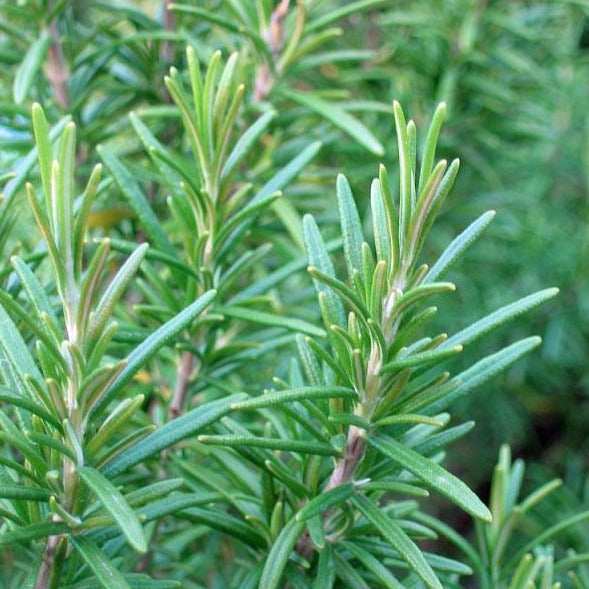Rosemary Plant
Product Details
 Growing Zones 8-10
Growing Zones 8-10
| Soil Type | Well Drained |
| Sunlight | Full, Partial |
| Drought Tolerance | Good |
| Mature Height | 4-5 Feet |
| Mature Width | 3-4 Feet |
| Fall Color | Green |
| Bloom Color | Blue |
| Shipping Restriction | AZ |
The Rosemary plant is an edible perennial herb that adds pizazz to a wide variety of food from meat and fish to bread and vegetables. Rosemary is attractive and delightfully aromatic. This herb is incredibly low maintenance.
Once established Rosemary tolerates sandy, rocky, dry, and heat conditions and is pest, disease, and deer resistant! Yep, this little beauty is one tough plant! It even repels insects and so much more...
Rosemary is extremely low maintenance when grown in the proper climates (zones 8 to 11). This perennial grows in full to part sun and is adaptable to most well-draining soil. Rosemary is able to tolerate sandy, rocky, and dry conditions and is deer resistant. Once established this edible herb is extremely drought tolerant. Fertilize with our balanced, slow-release fertilizer in spring.
When growing Rosemary in pots it is much easier to overwater than underwater. Allow the soil to dry out before watering well. The most common cause of death in Rosemary plants is over-watering. They do not like wet feet. Feed with our special fertilizer a second time in early fall.
Give as a gift or order one for yourself today!
How To Plant Rosemary?
Plant this herb in a spot that has well drained soil and gets full sun to part shade exposure in grow zones 8-10. Space these plants 2-3 apart and be sure to have a ph level of 6.0-7.0 for best results.
What Is Rosemary Used For?
This perennial herb has been known to be used for joint pains, hair loss and memory loss. You can also find this herb amongst the top choices for cooking and making spices.
What Plants Should I Mix With A Rosemary Bush?
Plant in a mixed bed to provide contrast to other perennials and shrubs. This herb performs well mixed in a garden with broccoli,. sage, and cabbage.
Rosemary is extremely low maintenance when grown in the proper climates (zones 8 to 11). This perennial grows in full to part sun and is adaptable to most well-draining soil. Rosemary is able to tolerate sandy, rocky, and dry conditions and is deer resistant. Once established this edible herb is extremely drought tolerant. When newly planted water deeply about once per week to help the roots grow correctly. Prune after flowering to encourage bushier dense growth. Fertilize with our balanced, slow release fertilizer in spring.
When growing Rosemary plants in pots it is much easier to over water than under water. Allow the soil to dry out before watering well. The most common cause of death in Rosemary plants is over-watering. They do not like wet feet. Feed with our special fertilizer a second time in early fall.
Delicate, light blue flowers bloom in spring to summer. The fragrant foliage is evergreen and add fantastic texture to your garden or mixed bed and a fabulous look to your home.
The Rosemary plant is a must have addition to your landscape or home. It makes an attractive border or groundcover. For tons of blue-lavender color and a rustic, lush look plant Rosemary in mass or clusters. Plant in a mixed bed to provide contrast to other perennials and shrubs such as the Phenomenal Lavender plant. This perennial herb performs well in a planter. Great news for cool climates! Just be sure the container drains well. Clay or terracotta pots are recommended for this herb. Lovely in a rock, rustic, cottage, herb, or cutting garden, Rosemary is pretty and aromatic.
For additional options, be sure to browse the Perennial Herbs collection.


















